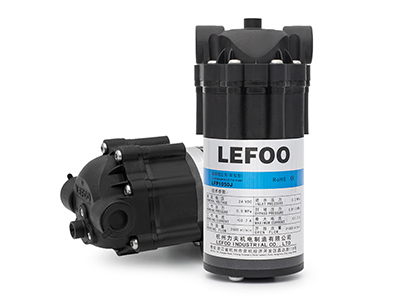Some Questions About Booster Pump for Water Purifier
(2023年03月15日)Ⅰ. Can the water purifier of the booster pump for water purifier be replaced with a self-priming pump?
It can be replaced. If the source water pressure is above 1 kg, the booster pump can be directly replaced with a self-priming pump; if the source water pressure is below 1 kg (well water), the self-priming pump should be placed in the first stage To the front of the filter element of the water heater, add a self-suction head to the front of the water inlet of the pump, and connect the two lines of the low pressure switch.
Ⅱ. What is the reason for the "gasping sound" inside the booster pump for water purifier?
There is air flow in the water pump, which is usually caused by low water pressure environment or blockage of the front filter element. Remove the water pump and test it separately to determine whether there is a problem with the water pump. If there is no fault, wait for the air in the pure water machine to be drained. Then you can.
Ⅲ. There is a noise in the booster pump for water purifier, which is similar to the sound of stone stirring. What is the reason?
It may be that the water quality of the water source is poor, or the particulate carbon of the pre-filter has entered the inside of the pump. In this case, before installing the filter, clean the filter first, connect the water inlet and outlet of the pump in reverse, and connect the pump to the pump. The impurities inside can be flushed out.
Ⅳ. Can the booster pump of the booster pump for water purifier?
The water pump is connected to tap water, no matter whether it is powered on or not, there will be water flowing out, because the booster pump for water purifier is not responsible for controlling the opening and closing of the water circuit.
Ⅴ. Will the booster pump for water purifier be connected to the tap water in reverse?
There is no water flow out of the reverse flow.
Ⅵ. The method of judging the fault of the booster pump for water purifier:
1. When the water pressure is normal, turn on the water source and power supply, start the water pump, and touch the water pump with your hand. If you feel the vibration of the booster pump, the pump is running normally.
2. When the pump is running, touch the booster pump for water purifier with a screwdriver, and the ear is close to the other end of the screwdriver. If the pump makes a strong and regular sound, the pump is working normally. The pump loses pressure.
Ⅶ. The booster pump for water purifier performance judgment criteria:
1. Appearance: It is required that the electrophoretic paint does not fall off, the shell and fasteners have no obvious rust, the pump head has no obvious injection defects, and the rubber feet are not damaged; the connection parts are not loose; the pump body is stable when laying flat; the nameplate is printed clearly and without warping , bubbles, etc.
2. Stall pressure: ≤145psi (1Mpa=10kg). (1psi=0.006895MPa).
3. Locked rotor pressure: the water outlet is completely closed, and the pressure at the water outlet port.
4. Noise: Noise ≤ 50dB (A).
5. The strength of the lead-out end: the lead-out end bears a tensile force of 40N along the axis direction for 10±1s, and the lead-out end should not be loose.
6. Self-priming height (self-priming pump): Self-priming height ≥ 2.0m.
7. Electric strength: The power port and the shell can withstand 500V/50Hz/lmin without flashover and breakdown.
8. Pressure resistance: In working and non-working states, it can withstand 1.2APa static water pressure for 15 minutes without deformation or damage, and there is no leakage of water in each connection part.
- このできごとのURL:



コメント